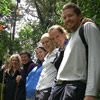BU students touch the clouds to save earth
 |
Expedition takes students high into the Andes Mountains to help conserve some of the worlds most threatened habitats |
Students from Bournemouth University have travelled to the remote cloud forests of Ecuador to help conserve some of South America’s most threatened wildlife and natural habitats.
The expedition, led by Dr Anita Diaz, Senior Ecology Lecturer in BU’s School of Conservation Sciences, involved six students from BU’s undergraduate programmes in Ecology and Wildlife Conservation and Environmental Protection and Management.
The group supported projects and conducted research at altitudes of up to 2,500 metres in the Choco’ Andean Corridor in the Andes Mountains of northwest Ecuador. The region is recognised as one of the most biodiverse in the world but under the highest threat of destruction.
The students went on the trail of some of Ecuador’s – and the world’s – most endangered species to monitor the disturbance effects of eco-tourism activities on their behaviour and habitats. The group often travelled and lived in fairly ‘primitive’ conditions but mature student Ann Thornton thoroughly enjoyed every minute and described the journey as an “exciting adventure”.
One major activity for the students involved the setting of camera traps to ‘observe’ the number of tourists visiting the region and to capture the frequency of animal sightings in the same spots. In particular, the team sought to map the numbers of threatened species such as the tree-dwelling Spectacled Bear, rare monkey species and big cats such as Jaguars, Pumas, Margays and Ocelots.
“This expedition to one of the world’s most remote and special habitats provided our students with the opportunity to evaluate how wildlife conservation theory can be applied in practice and to engage in research at a crucial frontier of current knowledge,” said Dr Diaz.
“Eco-tourism in Ecuador is the number one source of income as people travel to see these wonderful Cloud Forests,” she continued. “But the forests are under threat from logging and farming as large areas are turned over to crops or pasture for grazing which is also important to the economy. The tourists themselves pose a possible threat with their activities, potentially frightening away those species that remain in the forests. Large mammals have almost become extinct in Ecuador as a result of deforestation but it is studies such as this that help produce the most accurate information to assist those trying to conserve and protect the remaining rainforest.”
Another part of the expedition saw the students join local people, scientists from the Earthwatch organisation and both corporate and privately-funded volunteers in performing rapid environmental evaluation analyses of habitats. By observing the vegetation in areas that are recuperating from damage, it is possible to assess and understand nature’s clues as to the rate of recovery and the timescales involved.
For example, the strong presence of bromeliads could be an indicator to the presence of spectacled bear which rely on the plants as part of their staple diet or the presence of inter-connecting climbing vines in trees could point to species of monkeys who use them as a means of enhancing or extending their habitats.
“Plants tell us a lot about the animals which inhabit the forests,” said Dr Diaz. “We can actually measure the rate of restoration in the forests by what we observe as there is more information available than first meets the eye. Training our students in rapid assessment techniques has meant that they were able to take on the responsibility of training other volunteers in the field which is invaluable experience for their future careers. They all showed enormous commitment.”
Ann Thornton, now in the final year of the BSc (Hons) Ecology and Wildlife Conservation described the trip to Ecuador as an exciting adventure. Ann and her colleagues took part in the rapid assessment exercise but also trained a number of other volunteers, many of whom are sponsored by major companies.
“I took part in helping to develop the vegetation study which involved the rapid assessment of layers of plants such as ferns and orchids together with species of lichen,” said Ann. “I’m very proud that the methods we used worked so well and that the data we collected could actually benefit other scientists.
“We also trained a number of volunteers in Ecuador, many of them sponsored by companies such as Shell and Mitsubishi,” she continued. “Like us, none of those volunteers professed to be botanists or had training in botanical surveys but they were there, also like us, to take part in the hope of making a difference to the future of this beautiful and important area.
21/12/09
